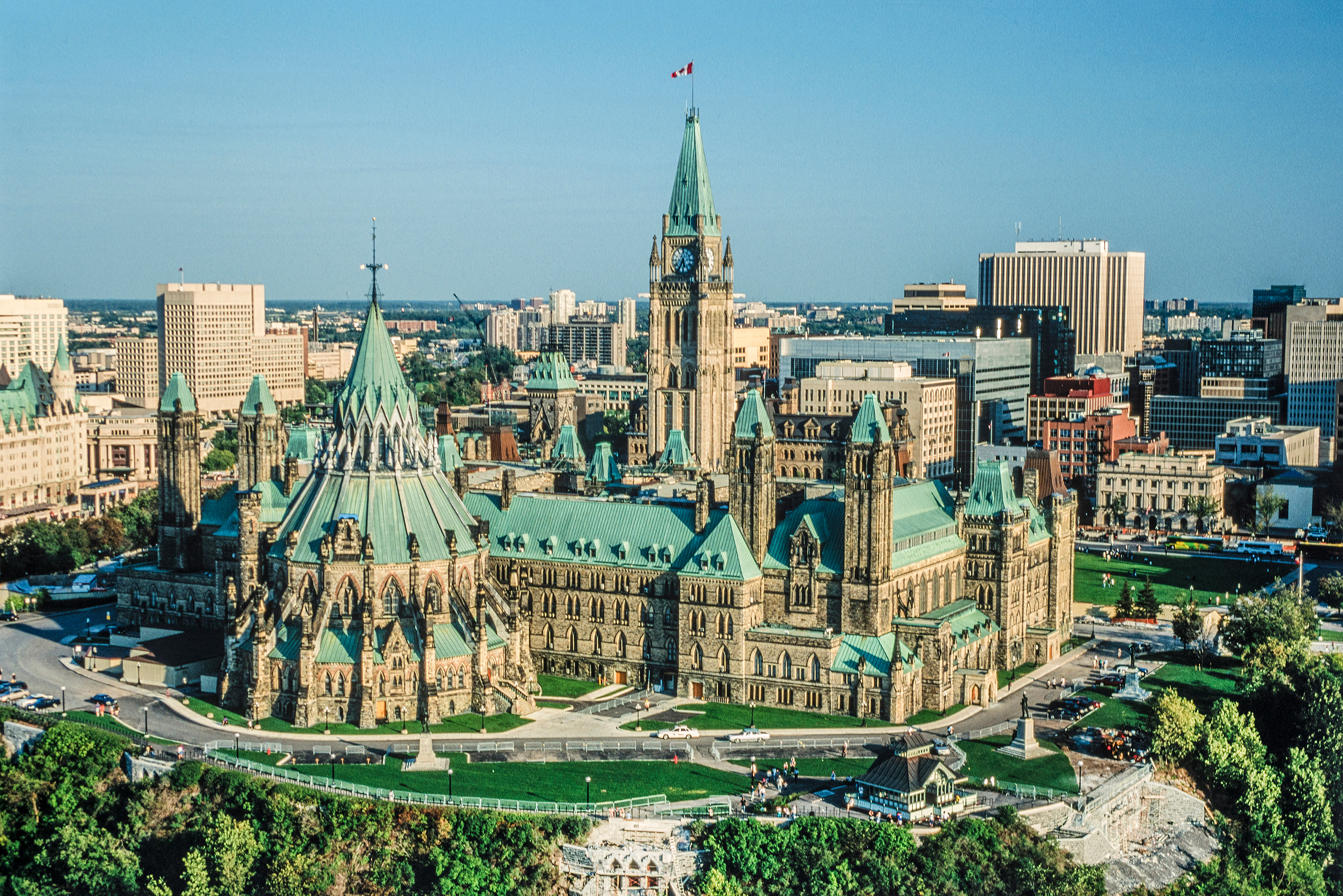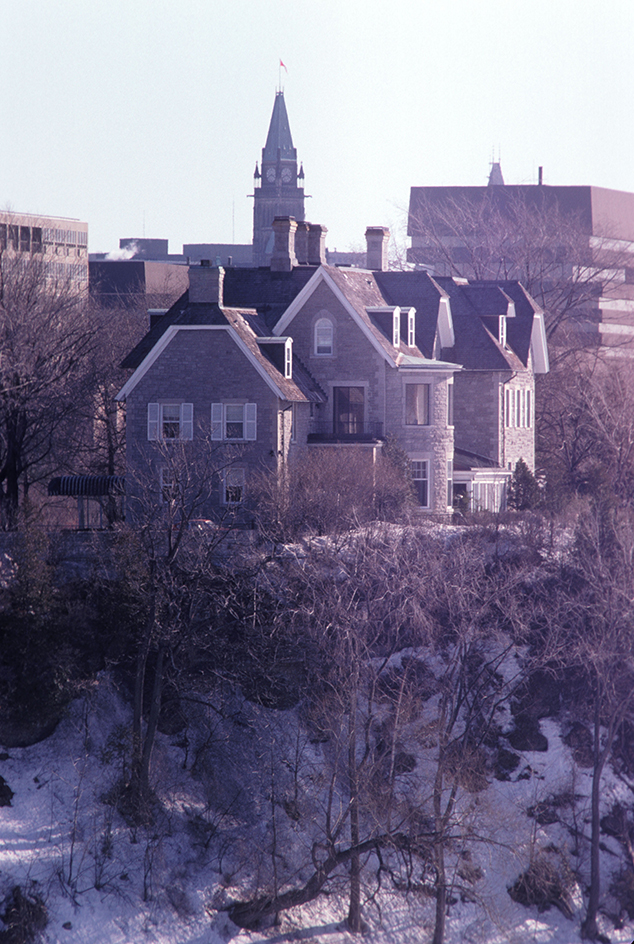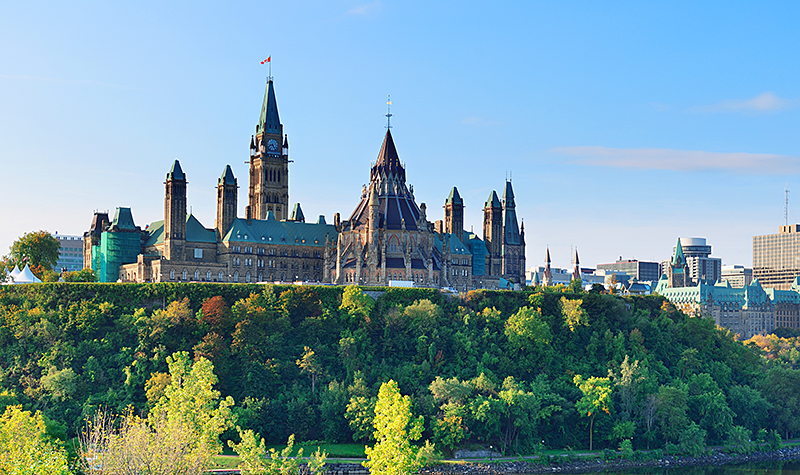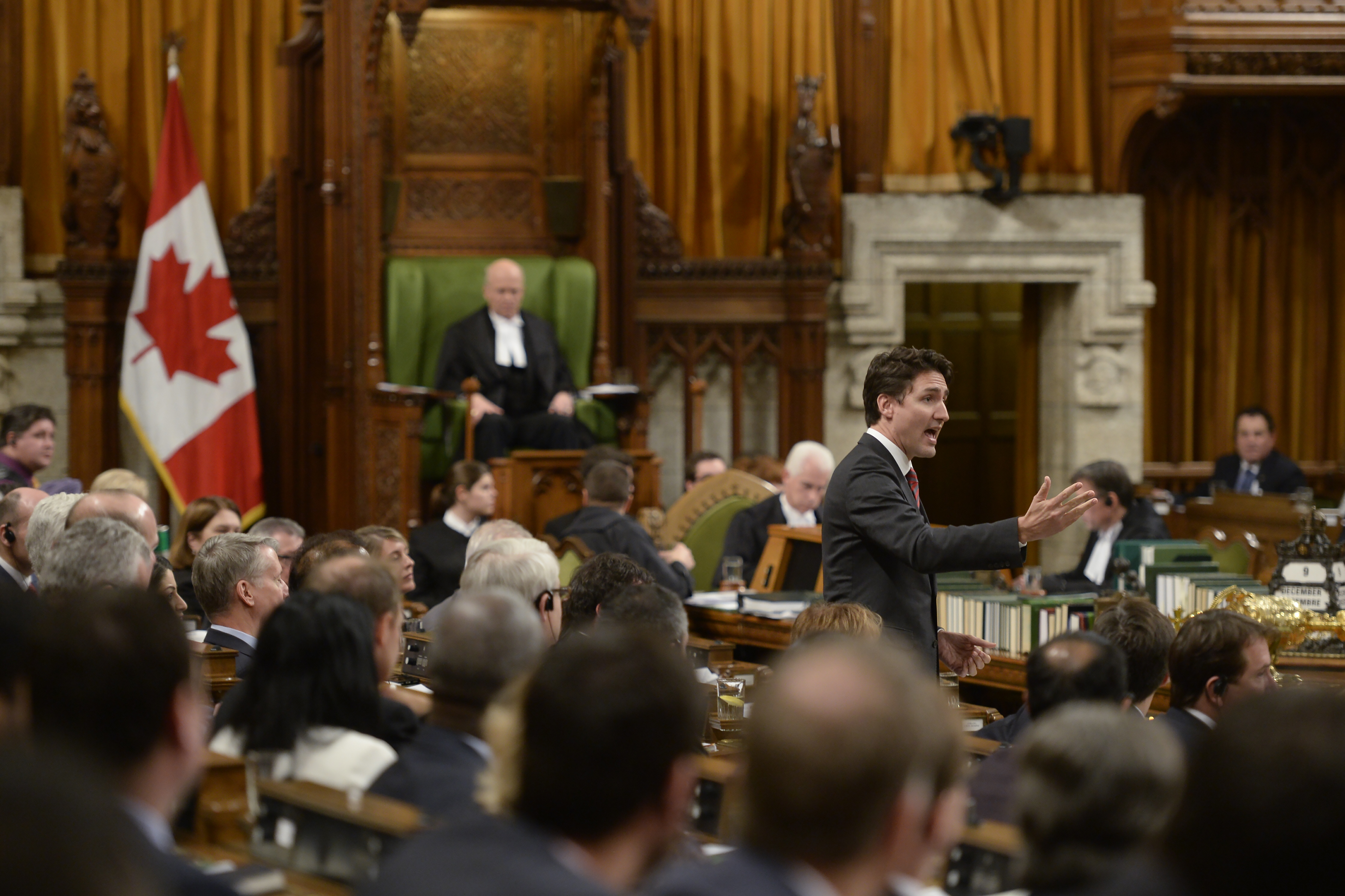Canada, Government of. Canada combines a federal form of government with a cabinet system. The federal form of government was originally patterned on that of the United States, and the cabinet system on that of the United Kingdom (also called Britain).

As a federation, Canada is made up of 10 provinces and 3 territories. The country works out its national problems through its central government in Ottawa, which represents all the people of Canada. Each province has its own government. The territories are self-governing, but the federal government plays a large role in their administration.

The cabinet system of Canada unites the legislative and executive branches of the government. The prime minister and all members of the Cabinet are usually members of the House of Commons. Occasionally, a senator may be in the Cabinet. Ministers are responsible for all their actions to the House of Commons, which is elected by the people. If the House of Commons defeats a piece of important government-supported legislation, or if it passes a vote of no confidence in the government, the prime minister must either resign or request that the governor general call a general election. See Cabinet (The cabinet system of government) .
Canada’s official head of state is the United Kingdom’s monarch. A governor general acts as the monarch’s representative. However, the governor general performs only certain formal and symbolic tasks. The prime minister directs the government.
The people of Canada elect members of the House of Commons. To vote in national elections, a person must be at least 18 years old and a Canadian citizen. Each province sets its own voting requirements for provincial elections. A voter must be at least 19 in British Columbia and at least 18 in other provinces.
Canada is a member of the Commonwealth of Nations, but it is not a dependency of the United Kingdom. Canada is independent, self-governing, and equal in rank to the United Kingdom and all other nations.
The constitution
Canada’s constitution is partly unwritten and partly written. The unwritten part consists mainly of general agreement and custom, including the cabinet system of government. The basic written section is the Constitution Act of 1982. It includes the British North America Act, which was the basic document governing Canada’s federal system from 1867 to 1982. Other written parts include ordinary laws and judicial decisions.
The founding fathers of the Canadian confederation wanted a strong central government. Thus, in the British North America Act, the provincial governments received only 16 powers then considered to be of minor importance. The federal government got all other powers. It also received power to disallow (reject) any provincial laws it believed undesirable.
However, powers given to the provinces—over such matters as education, health, and natural resources—became more important. Provinces became stronger and richer, and debates on the divisions of power between federal and provincial governments increased.
The Constitution Act of 1982 ended formal British control over amendments to Canada’s constitution. Previously, the British Parliament had to approve many of the amendments.
Today, amendments must be approved by Canada’s House of Commons; the provinces of Quebec and Ontario; two of the four Atlantic Provinces, representing at least half the region’s population; and two of the four Western Provinces, representing at least half of that region’s population. The Atlantic Provinces are New Brunswick, Newfoundland and Labrador, Nova Scotia, and Prince Edward Island. The Western Provinces are Alberta, British Columbia, Manitoba, and Saskatchewan. A province is considered to have approved an amendment when a majority of its voters have voted for it. The Canadian Senate also votes on constitutional amendments, but its rejection can only delay passage for 180 days.
Executive offices
The governor general.
Canada’s prime minister recommends a candidate for this office. The British monarch appoints the governor general as the Crown’s representative, usually for five years. Until 1952, the governor general came from the United Kingdom. In 1952, Vincent Massey became the first Canadian-born governor general.
The governor general originally had far-reaching powers. But these powers gradually dwindled. Today, the governor general follows the directions and advice of the Cabinet.

The prime minister
is the actual head of the government. Typically the leader of the political party with the most seats in the House of Commons, the prime minister is indirectly elected by the people. No law establishes this office. The office is simply a necessity, worked out long ago in England. No government could carry on without Parliament’s support. The leader of the largest group in the House gradually became the prime (first) minister of the Cabinet.
The prime minister is appointed by the governor general, who follows the wishes of the majority in the House. The prime minister holds office only with the backing of this majority of legislators. A prime minister who loses this backing must either resign, request that the governor general call a new general election, or suggest that the governor general find a new leader with the support of a majority of the House. Parliament can control the actions of the prime minister by giving or withholding support. See Prime minister of Canada.

The Cabinet
helps the prime minister direct the government. The Cabinet consists of a varying number of ministers chosen by the prime minister, usually from the governing party in the House, and appointed by the governor general. Ministers usually head government departments. They lose their positions if the government resigns. Ministers may also lose their positions if the Cabinet changes. A deputy minister serves as the permanent head of each government department and reports to the department’s minister. Deputy ministers are civil servants. The Cabinet also may include ministers of state, junior Cabinet officials who do not head their own departments. Ministers of state often are responsible for aiding senior Cabinet ministers.
The Parliament
The Parliament is the national legislature of Canada. In a strict legal sense, Parliament includes the House of Commons, the Senate, and the Crown represented by the governor general. But the term Parliament is also used to refer to just the national legislature of Canada. The Canadian legislature has two houses—an upper house called the Senate and a lower house called the House of Commons.

The Senate
normally has 105 members. The senators and the speaker, the Senate’s presiding officer, are appointed by the governor general on the prime minister’s recommendation. A new prime minister usually recommends a new speaker. Senators must retire when they reach age 75.
The Atlantic Provinces—New Brunswick, Newfoundland and Labrador, Nova Scotia, and Prince Edward Island—send a total of 30 members to the Senate. The Western Provinces—Alberta, British Columbia, Manitoba, and Saskatchewan—send 24. Quebec and Ontario each send 24 members. The Northwest Territories, Nunavut, and Yukon each have one senator.
The Senate has less power than the House of Commons. Since 1982, amendments to Canada’s constitution have required approval from the House and from a certain number—usually seven—of the provincial assemblies. The Senate votes on amendments, but its rejection can only delay passage of an otherwise approved amendment for 180 days. The Senate cannot introduce bills that involve the spending of money.
The House of Commons
consists of members elected by the people. According to Canada’s constitution, general elections must be held at least every five years, though in practice they are held every four years or more frequently. The number of House members for each province changes based on Canadian census results. For the number of members of Parliament for each province, see the table in each province article.
Each House member represents a district, called a constituency or a riding, of a province. Members do not have to live in the constituency, or in the province, they represent. The House elects one of its own members as speaker to preside over meetings. The speaker holds office until general elections are called.

Following each general election, the political party that won the most seats in the House of Commons usually forms a government, and the leader of that party becomes prime minister. The party that wins the second most seats is known as the official opposition. If no party wins a majority (more than half) of the seats in the House of Commons, then the party with the most seats may try to form a minority government. In a minority government, the party with the most seats tries to govern with the support of lawmakers from other parties.
The courts
The Canadian justice system is made up of the Supreme Court of Canada; federal courts; provincial and territorial courts; the Tax Court of Canada; and martial (military) courts. Judges of most of the courts are appointed by federal authorities. Provincial and territorial authorities appoint judges of the lower provincial and territorial courts. Canadian law mandates that all judges must retire at the age of 70 or 75, depending on the court.
The Supreme Court of Canada
is the nation’s highest court of appeal. The Supreme Court is made up of a chief justice and eight associate judges called puisne << PYOO nee >> judges. As a general court of appeal, it handles cases dealing with all areas of the law.
Federal courts
include the Federal Court of Appeal and the Federal Court. The Federal Court of Appeal hears appeals from the Federal Court and the Tax Court of Canada. It is made up of a chief justice and 12 other judges. The Federal Court hears cases brought against or by the Canadian government, or affecting the government. It also handles disputes between provinces and between the federal and provincial governments. It consists of a chief justice and 32 other judges.
Provincial and territorial courts
include, in order of descending authority, courts of appeal, superior courts, and lower courts generally known as provincial courts. The lower courts usually have a number of separate, specialized divisions. Such divisions include traffic, small claims, family, criminal, and other divisions. Unlike most provinces and territories, Nunavut does not have a lower, territorial court. The Nunavut Court of Justice hears cases at both the territorial and superior court levels.
Tax and martial courts.
The Tax Court of Canada primarily hears cases involving income taxes. These cases may involve disputes between the Canadian government and companies or individuals. Martial courts include the Court Martial Appeal Court and lower military courts. Martial courts hear cases dealing with the discipline of members of the armed forces, as well as civilians who accompany the armed forces on active duty.
Money and taxation
Only the federal government may coin money. Coins are made at the Royal Canadian Mint in Ottawa and in Winnipeg. The Bank of Canada, a central bank that controls credit and currency, issues all paper money.
The taxation powers of the Canadian government are unlimited. Provincial governments may impose direct taxes, which include income and property taxes. They may also impose provincial sales taxes. The federal and provincial governments both levy individual and corporate income taxes.
Provincial and territorial governments
The ten provinces.
Each province has a lieutenant governor who is appointed by the governor general in council—that is, the governor general of Canada acting with the advice and consent of the Cabinet. The lieutenant governor once served the federal government as the governor general once served the British, but the office is now an honorary position. A premier actually heads the government of each province. Each premier leads the majority party in the legislature. Each province has an elected one-chamber legislature. This body is called the Legislative Assembly except in Quebec, where it is called the National Assembly, and in Nova Scotia and in Newfoundland and Labrador, where it is called the House of Assembly.
Each province controls such matters as education, administration of justice, municipal institutions, property, and civil rights. The federal government can disallow (reject) any law passed by a provincial legislature. However, the federal government has disallowed only about 100 of the thousands of bills adopted by the provinces. The practice of disallowance generally has fallen into disuse.
The three territories
have separate governments with much less power than those of the provinces. Generally, the territorial governments provide for law enforcement, medical services, and schools in the towns. All three territories are governed by a premier, an executive council, and a Legislative Assembly. Members of the Legislative Assembly are elected by the people. The premier and the rest of the executive council are chosen by the Assembly from among its members. Each of the territories has a commissioner—an honorary head of government appointed by the federal government. Each of the three territories sends one representative to the House of Commons in Ottawa.
Local government
The provinces and territories regulate local government. Each has a different system. Generally, each province is divided into counties or districts. These counties or districts are divided into cities, towns, villages, and townships. Elected councils govern the municipalities. The head of the local government is usually a mayor, reeve, warden, or overseer. Other council members are called controllers, aldermen, or councillors. Municipal governments direct such activities as road repair, water supply, and police and fire protection. They gain much of their revenue from property taxes.
Political parties
The two most prominent parties in Canada are the Liberal Party of Canada and the Conservative Party of Canada. The Conservative Party of Canada was created in December 2003 by a merger of the Progressive Conservative Party and the Canadian Alliance.
Traditionally, the Liberals have favored the expansion of social programs and provincial rights. The Conservative Party of Canada has supported controlled government spending, lower taxes, and increased support of the military.
When the Conservative Party of Canada was created, the Liberals and the Progressive Conservatives historically had been the strongest national parties. Both could trace their origins to before 1867, when the British North America Act established the Dominion of Canada. The Progressive Conservative Party was officially known as the Conservative Party until 1942.
The New Democratic Party and the Bloc Québécois are two other important federal parties. The New Democratic Party was formed in 1961 by trade unions, a socialist party called the Co-operative Commonwealth Federation (CCF), and independent left-wing Canadians. The party favors social welfare measures. It opposes Canadian participation in such military alliances as the North Atlantic Treaty Organization (NATO) and the North American Aerospace Defense Command (NORAD).
The Bloc Québécois was formed in 1990 by a handful of members of Parliament from Quebec. The party advocates the creation of a sovereign Quebec, and it quickly gained support among French-speaking Quebecers. From 1993 to 2011, the Bloc Québécois held between half and three-fourths of Quebec’s seats in the House of Commons, giving the party an influence in national politics despite its regional base.
International relations
Canada has been completely free since the Statute of Westminster in 1931 ended the last British controls over Canada. Canada now conducts its foreign relations with the United Kingdom and other Commonwealth nations in the same way it conducts relations with other nations.
Relations with the United States.
Canada’s closest economic and social ties are with the United States. The two countries share more than 4,000 miles (6,400 kilometers) of common border, and their relations are exceptionally friendly. Boundary problems are settled by the International Joint Commission (see International Joint Commission ). Many Canadians criticize U.S. foreign policy and oppose Canada’s role in NORAD.
In 1994, the North American Free Trade Agreement (NAFTA) united Canada, Mexico, and the United States in one of the world’s largest free trade zones . It gradually eliminated tariffs on most goods produced and sold in North America. The three countries renegotiated NAFTA in the late 2010’s. The updated pact, which took effect in 2020, maintained the largely tariff -free trade zone established by NAFTA. It also introduced new rules in such areas as e-commerce, the environment, and labor practices. In Canada, it was called the Canada-United States-Mexico Agreement (CUSMA).
Relations with other countries.
Canada conducted relations with other foreign countries through the British diplomatic service until the 1920’s. After that, Canada sent its own diplomatic representatives to foreign countries and received other countries’ representatives in return. The first exchange of representatives was with the United States, in 1927. Diplomats now represent Canada in nearly all the leading countries. Canada became a charter member of the United Nations in 1945, and of the North Atlantic Treaty Organization in 1949.
Armed forces
Until 1968, Canada had an army, navy, and air force that were separate from one another. But in that year all Canadian military forces were merged into one unit called the Canadian Armed Forces. The chief of the defence staff directs the armed forces and reports to the minister of national defence. Canada and the United States formed the Permanent Joint Board on Defence in 1940 to cooperate in defending North America.
Canada has two professional military colleges—the Royal Military College of Canada in Kingston, Ontario; and the Collège militaire royal de Saint-Jean in Saint-Jean-sur-Richelieu, Quebec. The Canadian Armed Forces also maintains staff colleges, cadet corps, and officer-training programs in colleges and universities.
